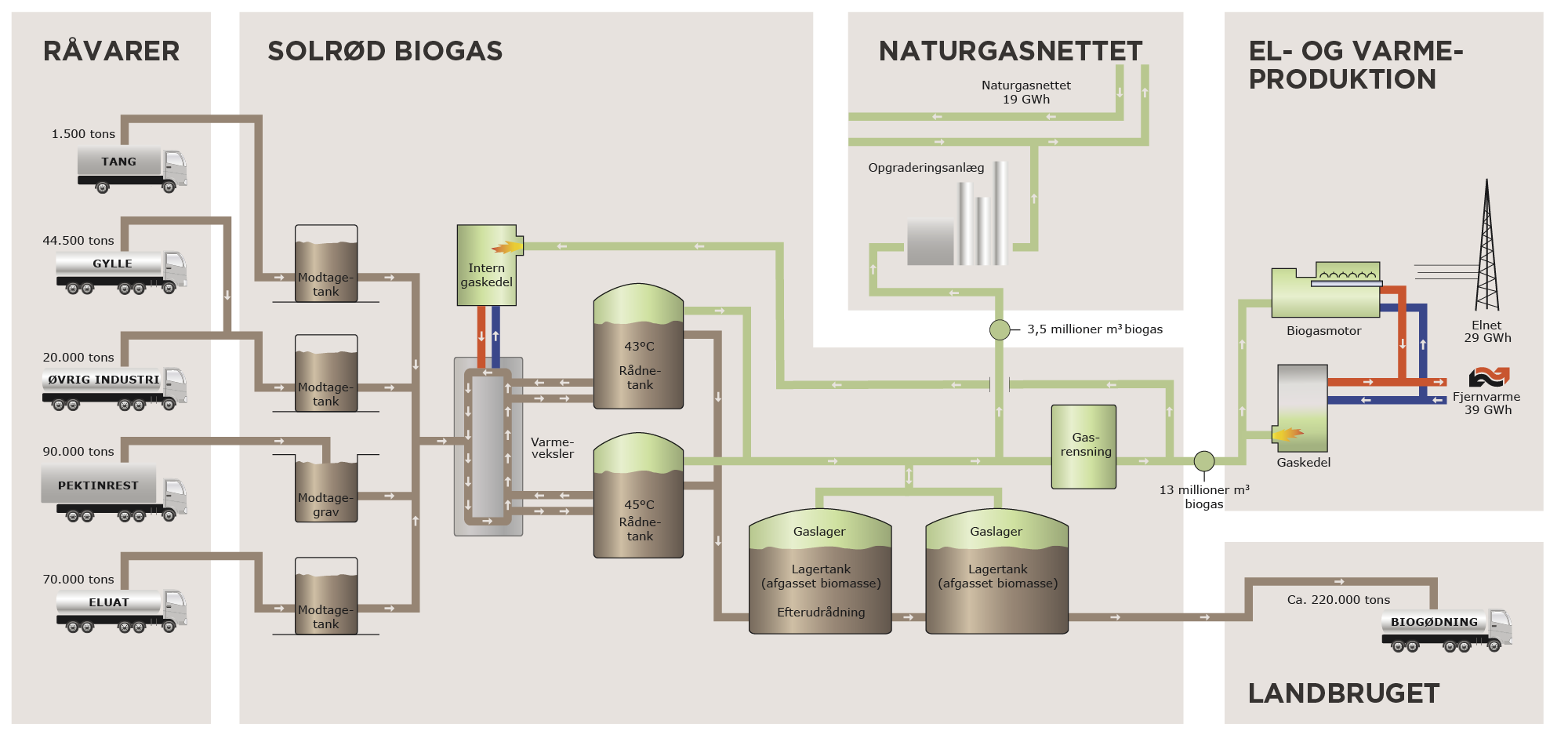What is biogas?
Primarily consisting of methane and carbon dioxide, biogas is a combustible mixture of gases, convertible into energy. Biogas can be extracted by a biological process which converts organic material into biogas in an oxygen-deficient environment. The biomass is made up by biological residual products, seaweed and algal sludge removed from beaches as well as livestock manure from adjacent farms.
The main constituents of raw biogas is about two-thirds methane and one third carbon dioxide. They can be utilised directly as fuel in, for instance, a gas generator to generate electricity. Gas generators need cooling, a process that produces heated cooling water. A heat exchanger transfers the heat of the cooling water to water, which can be used as district heating to households and offices or for industrial production.

Environment and climate
Biogas from livestock manure and organic residual is a carbon-neutral fuel. When replacing fossil fuels such as coal, oil or natural gas, it contributes to reducing greenhouse gas emission.
But that is not all. Biogas production represents better use of agricultural livestock manure, further reducing greenhouse gas emission and leaching of nutrients to the aquatic environment.
Carbon-neutral fuel
When plants grow, they absorb carbon dioxide from the atmosphere and use the carbon of carbon dioxide as a building stone. Later, the plants will perhaps be converted to animal feed and be eaten by a pig. The carbon is now inside a pig, and some of it will be transported into the liquid manure and then to the biogas facility, there to be converted into methane and carbon dioxide. Once biogas is used as fuel, the carbon dioxide will be emitted to the atmosphere again.
In this way, the emitted carbon dioxide will be offset by the carbon dioxide absorbed by the plants from the atmosphere when they grew.
The process makes biogas a carbon-neutral fuel, and when it replaces fossil fuels, it recirculates carbon dioxide and counteracts accumulation of greenhouse gases in the atmosphere.
Reduced leaching and accumulation of nutrients
Nutrients like nitrogen leach from liquid manure and fertiliser to the aquatic environment, and subsequently seeps from the soil to streams, lakes and coastal waters.
When nutrients leach to the aquatic environment or seaweed is left to decompose on beaches, the processes add nutrients to algae which begins to grow. If sufficient nutrients are added, the algae may grow to the extent that they consume all oxygen in the water surrounding them, leading to oxygen deficiency. In turn, this process may cause dead zones in the water, both in the water column and at the bottom.
Thus, reuse of seaweed and collection of liquid manure for use in the biogas facility solve two problems at once – both leaching and accumulation of nutrients from farms and beaches.

Underlying technology
Solrød Biogas uses a well-known technology where raw material – seaweed from the beach, organic residues from the food industry and manure from agriculture – is discharged into an oxygen-poor environment. The central process of the biogas plant takes place in the reactor tanks, where bacteria at a temperature of about 45 degrees Celsius convert the organic material into biogas. After the biomass has been degassed in the reactor tanks, it is stored and then delivered to farms as fertilizers.
The biogas is delivered to three different customers.
First, the biogas is supplied to Vestegnens Kraftvarmeselskab I/S (VEKS), where it is used in a gas engine that produces electricity and heat. The electricity is sold on the electricity market, while the heat is distributed via the local heating company Solrød Fjernvarme a.m.b.a.
Secondly, the biogas is supplied to Solrød Fjernvarme’s own local gas engine at Havdrup Heating Plant. Here, the gas engine interacts with other green energy sources to ensure green heating for Havdrup.
Thirdly, the biogas is delivered to Solrød Bioenergi ApS’s upgrade plant. Here, the gas is cleaned before it is released onto the natural gas grid, using it as a source of heat supply in households with gas boilers.
Sådan gør vi

Solrød Biogas extracts sustainable energy from organic matter – biomass – through a controlled process where the residue can be used as fertilizer.
Here’s an overview of the different steps in the process:


